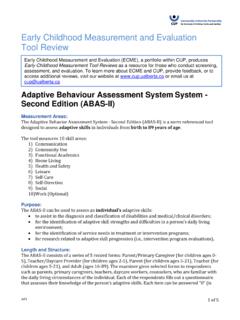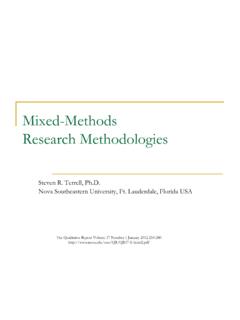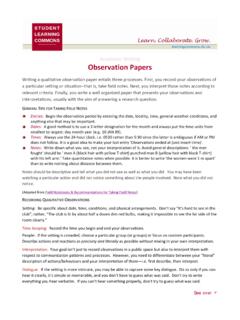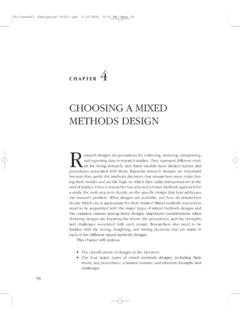Transcription of Sampling Design in Mixed Research (MR)
1 Sampling Design in Mixed Research (MR)Kathleen M. T. Collins, Methods Webinar SeriesNovember 20, 2018 Setting the Stage What is a methodology? What is a method? What steps comprise the planning & Design stage of the MR process?Methodology Teddlie and Tashakkori (2009) interpret methodology as comprising a "broad approach to scientific inquiry specifying how Research questions should be asked and answered (Teddlie & Tashakkori, [T&T] 2009, p. 21). Furthermore, they also state that a methodology encompasses the researcher's "world view considerations, general preferences for designs, Sampling logic, data collection and analytical strategies" and includes " guidelines for making inferences, and the criteria for assessing improving quality." (T&T, 2009, p. 21) T&T (2009) also specify that the researcher's selections of methods are predicated by the researcher's "overall methodological orientation.
2 " (p. 21) Subsequently, the planning & Design stage is impacted by your interpretation about what are credible data, and what is the approach to collect and analyze these data relative to addressing your Research question (Collins, 2010) Mixed Research Design Logic A set of decisions about timing, integration, and priority of quantitative and qualitative methods that researchers have to make when designing a Mixed methods study. (T & T, 2009, p. 107) Mixed Designs A strand (T&T, 2009) refers to the activities occurring at the conceptual ( , forming the Research purpose/question), methodological/analytical ( , implementation of methods/ analysis), andinferential( , conclusions, explanations) stages of a Mixed Research study. A study can have one or more strands dependent upon the complexity of the Research 2 Planning Design (Collins, 2010)Identifying the Study's Mixed DesignIdentifying the Sample Scheme and Sample Size Per PhaseIdentifying the Balance of each Sample Relative to the Study's ObjectiveValidity Designs(Collins, 2015)Focus and Goal The term Sampling Design refers to two distinct decisions yet interrelated decisions: decide on the strategyto select the sample ( , scheme) and decide on the sample size per strand of the study.
3 Inclusive Sampling Model (Collins, 2010) The goal of this webinar is to introduce an inclusive Sampling model comprising three components: discussion of selective Sampling typologies, presentation of the steps in the Mixed Sampling process, and recommendationsto address Sampling issues related to four criteria impacting Sampling designs: representation, legitimation, integration, and politics. Sample Design Sample schemes and sample size Information on the following slides is based on the following chapter: Collins, K. M. T. (2017). Sampling designs in educational Research . In D. Wyse, E. Smith, L. Suter, & N. Selwyn (Eds.), British Educational Research Association (BERA)/ SAGE Handbook of Educational Research (Vol,1, pp. 280 292). London, England, Decisions Identify your perspective: My perspective these decisions are influenced by the researcher s interpretations ( , philosophical assumptions) about what constitutes credible data, and that data are created by the researcher not simply collected.
4 Rather, data construction is filtered by the researcher s experiences, qualifications, beliefs, and motivations for exploring the Research topic, all of which are influenced by the context surroundingthe inquiry(Maxwell, 2010).9 Examples of Decisions & Criteria quantitative Goal: Aim of the study and the sample characteristics are identified quantitative Sampling The goal is to select a representative sample. The process begins by defining the target population, and identifying the accessible population, which the researcher has reasonable access. The Sampling frame is then delineated to list all elements in the selected sample scheme and sample size determined by a power analysis (gpower software or tables) 10 Goal qualitative Based on the concept of Sampling for meaning Individual s perspective (IP) is context specific and is based experientially, not fixed Relationship between researcher and participant can shape collected data, and Sociocultural standards (culture and community) shape the IP Information rich data and achieving saturation11 Goal qualitative Based on the concept of Sampling for meaning Individual s perspective (IP) is context specific and is based experientially, not fixed Relationship between researcher and participant can shape collected data, and Sociocultural standards (culture and community)
5 Shape the IP Information rich data and achieving saturation12 Data Saturation To achieve data saturation is influenced by a number of factors: Data quality - amount & complexity of data collected Sample heterogeneity Researchers resources Number of individuals who are analyzing and interpreting the data (Guest, Bunce, & Johnson, 2006) The larger the degree of sample heterogeneity, the larger the number of cases recommended to achieve saturation (Guest et al., 2006) 13 Objective Generalization Probability Sampling external generalizations selection of a representative sample generalized to the population Purposive Sampling - internal generalizations, analyses of data obtained form a subset of elite informants who are representative of the sample from which they have been selected and the generalizations are applied to that sample Analytic evidential quality of the data, generalize a particular set [case study] to some broader theory (Miles, Huberman, & Salda a2014) Case-to-case transfer generalize across cases and the transfer is supported by theory (Firestone, 1993) Naturalistic perceptions of the consumers of the Research who reflect on the applicability of the conclusions to their experiences (Stake, 2005)
6 14 Rationale & Purpose The rationalefor developing the sample Design is filtered by the Research question, type of generalization, available resources. Purpose: quantitative approach: Attain adequate power, population characteristics are represented in the sample, qualitative approach: Represents the characteristics of interest, attain quality data to reach saturation and theory development, as in the case of grounded theory, or theory confirmation Strategy:Prebriefinginterviews to guide sample selection, if appropriate given the Design parameters15 Mixed Research Design In Mixed Research , the sample Design per phase can facilitate or can limit the degree that inferences can be made approximately equally from results generated in the quantitative and qualitative phases. GOAL: Interpretive consistency is the consistency between the Sampling Design and the credibility of the researcher s inferences and chosen generalizations Collins, 2015; Collins, Onwuegbuzie, & Jiao, 2006).
7 16 Sampling Typologies Kemper, Stringfield, & Teddlie, 2003 Teddlie& Yu, 2007 Onwuegbuzie& Collins, 2007 (See Collins [2010] for references) Sampling typologies formed the basis for the Integrative typology developed by Collins (2010) as presented in the following typology (Collins, 2010)Relationship between the samples selected and the time orientationRelationship between the samples selected and the time orientationRelationship between the quantitative and qualitative samplesRelationship between the quantitative and qualitative samplesRelationship between combination of Sampling schemes & type of generalizat ionRelationship between combination of Sampling schemes & type of generalizat ionRelationship between the varying types of data collected and RQRelationship between the varying types of data collected and RQRelationship between emphasis of approach and forming meta inferences generalizat ionsRelationship between emphasis of approach and forming meta inferences generalizat ions181.
8 Samples Selected & Time Orientation Concurrent approach: independent relationship between the data collection and analysis per strand, and integration occurs at the study s conclusion Sequential approach: Dependent relationship between the data collection and or analysis. Analysis of data in strand 1 informs decisions regarding data collected in strand 2. Data analysis always begins before all the data are Relationship between the samples (Onwuegbuzie & Collins, 2007)Identical Same participants in each phaseIdentical Same participants in each phaseParallel Different participants who share same characteristicsParallel Different participants who share same characteristicsNestedSample in phase 2 represents a sub sample of sample in phase 1 NestedSample in phase 2 represents a sub sample of sample in phase 1 Multilevel Samples have different relationship with the phenomenon Multilevel Samples have different relationship with the phenomenon 204.
9 Type of data collected A. Combination of both data types : quantitative Data and qualitative Data B. Transformed Data: Quantitized and Qualitized Also referred to as cross over analysis (Onwuegbuzie & Combs, 2010) (cf: Onwuegbuzie, Frels, Leech, & Collins, 2011) Quantitized Process: Process of converting qualitative data to numerical codes that can be analyzed statistically (Miles et al. 2014) ( , descriptive data in terms of frequencies and factor analyzing themes) Qualitized Process: Process of converting quantitative data to into data that can be analyzed qualitatively ( , modals)215. Emphasis of Approach Representativeness/saturation trade off Trade off between meeting the requirement of external generalization versus meeting the requirement of transferability (Teddlie & Tashakkori, 2009, p. 184)Placing emphasis on one approach ( , strand) in contrast to the other approach, when formulating meta inferences and generalizations.
10 Placing approximately equal emphasis on both approaches , when formulating meta inferences and generalizations. 225. Mixed Research Emphasis The researcher may use the Research question to determine the emphasis placed upon each strand in terms of formulating meta-inferences. Specifically, the researcher makes one of two decisions 1. to give one strand of the study ( , qualitative ) more emphasis or a higher degree of status ( , dominant status) 2. to give all strands of the study ( , qualitative and quantitative ) approximately equal status or emphasis in terms of formulating meta-inferences 23 Goal of the Study (Collins, 2010) What is the goal or long term aim of this study? Who are the stakeholders who will be impacted by this study? What sample characteristics ( , age, culture, gender, social class) do you perceive will enable you to address the goal of this study?
















